jump start JEEP GRAND CHEROKEE 2007 WK / 3.G SRT Owners Manual
[x] Cancel search | Manufacturer: JEEP, Model Year: 2007, Model line: GRAND CHEROKEE, Model: JEEP GRAND CHEROKEE 2007 WK / 3.GPages: 395, PDF Size: 6.1 MB
Page 236 of 395
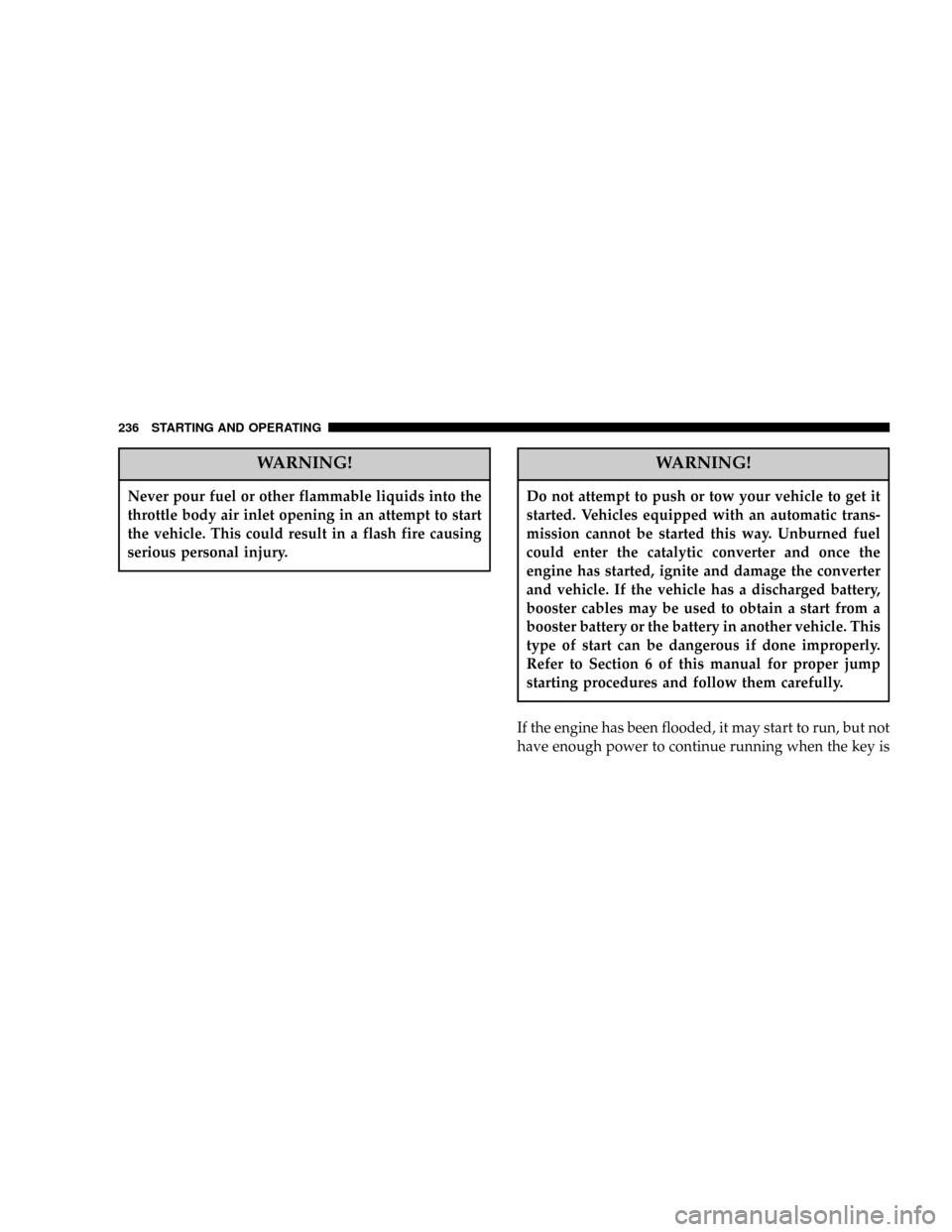
WARNING!
Never pour fuel or other flammable liquids into the
throttle body air inlet opening in an attempt to start
the vehicle. This could result in a flash fire causing
serious personal injury.
WARNING!
Do not attempt to push or tow your vehicle to get it
started. Vehicles equipped with an automatic trans-
mission cannot be started this way. Unburned fuel
could enter the catalytic converter and once the
engine has started, ignite and damage the converter
and vehicle. If the vehicle has a discharged battery,
booster cables may be used to obtain a start from a
booster battery or the battery in another vehicle. This
type of start can be dangerous if done improperly.
Refer to Section 6 of this manual for proper jump
starting procedures and follow them carefully.
If the engine has been flooded, it may start to run, but not
have enough power to continue running when the key is
236 STARTING AND OPERATING
Page 291 of 395
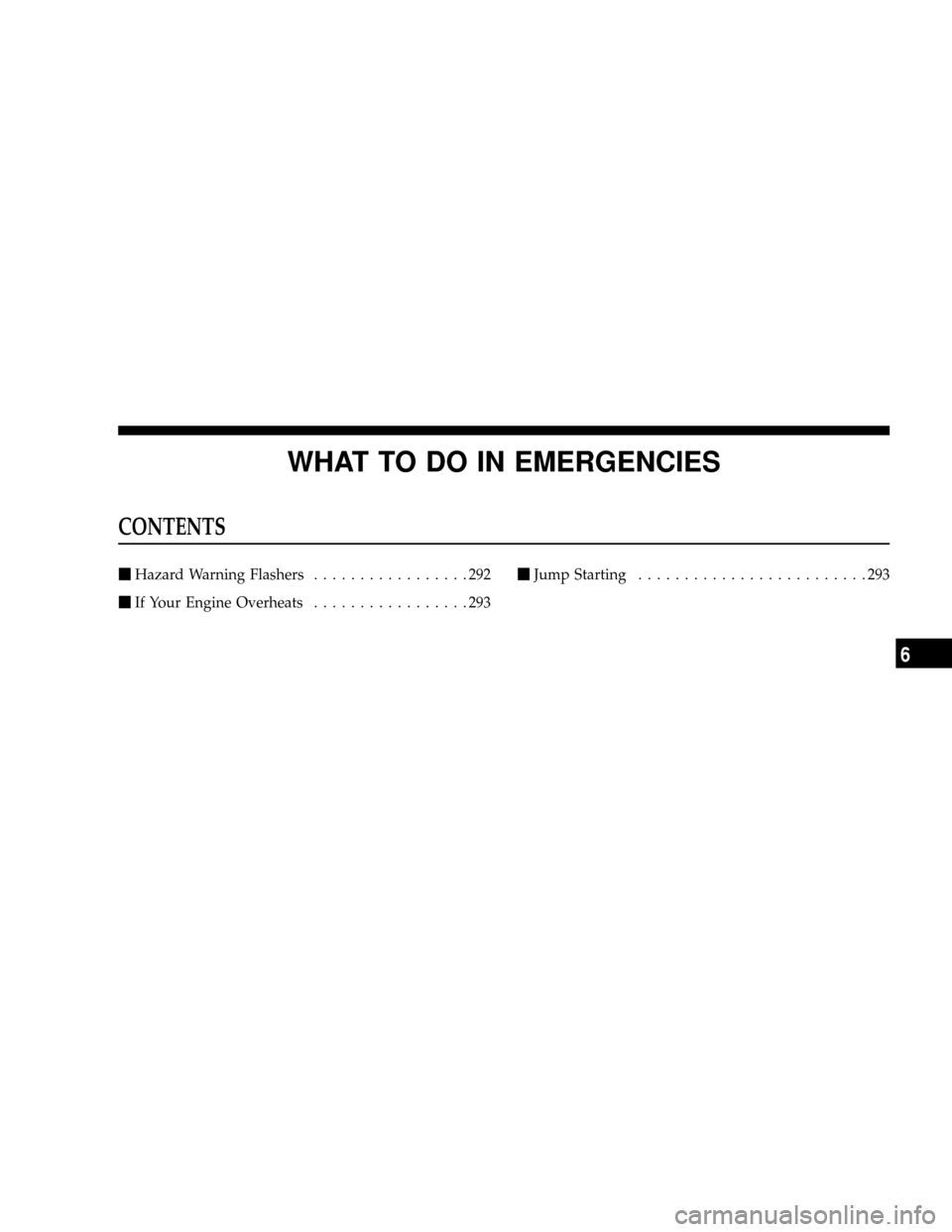
WHAT TO DO IN EMERGENCIES
CONTENTS
mHazard Warning Flashers.................292
mIf Your Engine Overheats.................293mJump Starting.........................293
6
Page 293 of 395
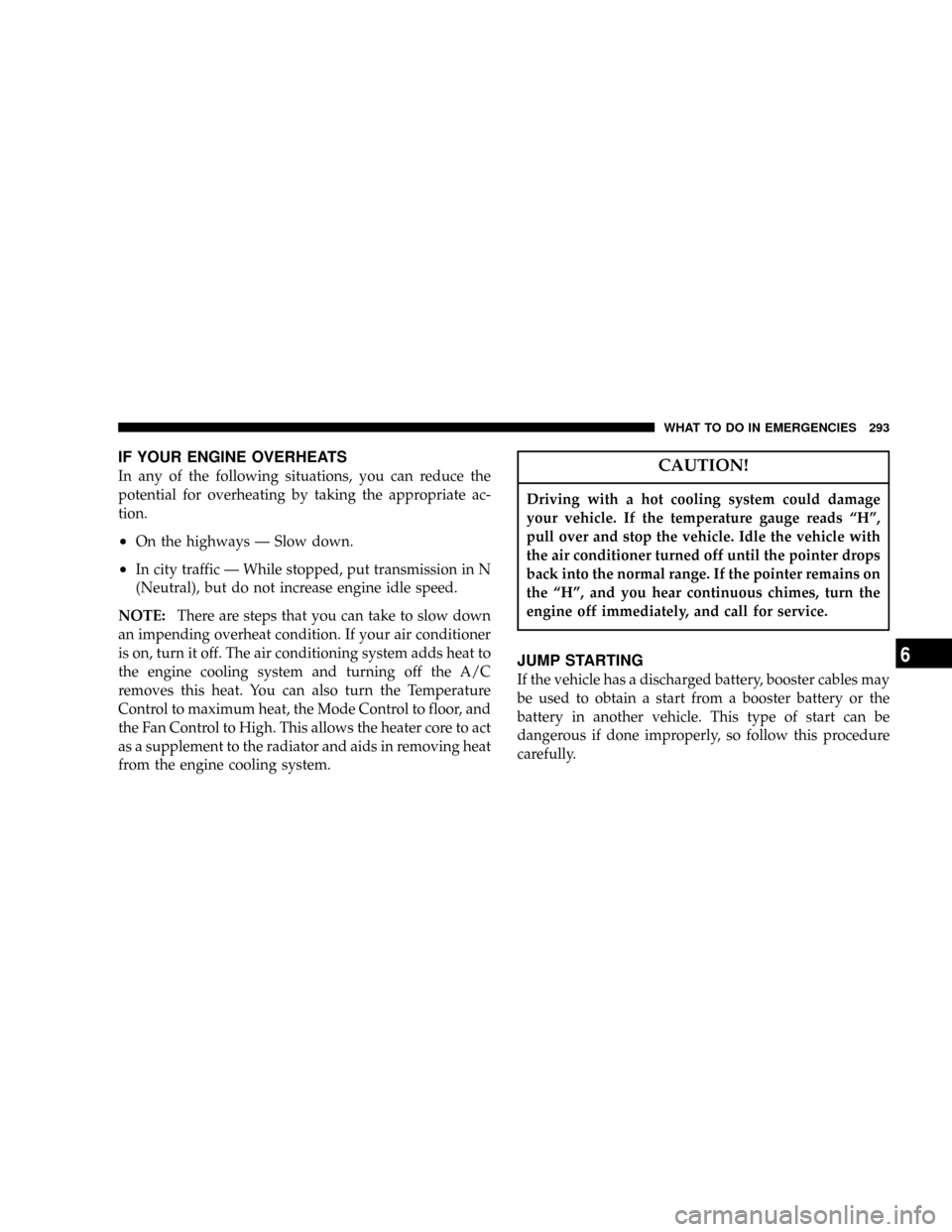
IF YOUR ENGINE OVERHEATS
In any of the following situations, you can reduce the
potential for overheating by taking the appropriate ac-
tion.
²On the highways Ð Slow down.
²In city traffic Ð While stopped, put transmission in N
(Neutral), but do not increase engine idle speed.
NOTE:There are steps that you can take to slow down
an impending overheat condition. If your air conditioner
is on, turn it off. The air conditioning system adds heat to
the engine cooling system and turning off the A/C
removes this heat. You can also turn the Temperature
Control to maximum heat, the Mode Control to floor, and
the Fan Control to High. This allows the heater core to act
as a supplement to the radiator and aids in removing heat
from the engine cooling system.
CAUTION!
Driving with a hot cooling system could damage
your vehicle. If the temperature gauge reads ªHº,
pull over and stop the vehicle. Idle the vehicle with
the air conditioner turned off until the pointer drops
back into the normal range. If the pointer remains on
the ªHº, and you hear continuous chimes, turn the
engine off immediately, and call for service.
JUMP STARTING
If the vehicle has a discharged battery, booster cables may
be used to obtain a start from a booster battery or the
battery in another vehicle. This type of start can be
dangerous if done improperly, so follow this procedure
carefully.
WHAT TO DO IN EMERGENCIES 293
6
Page 295 of 395
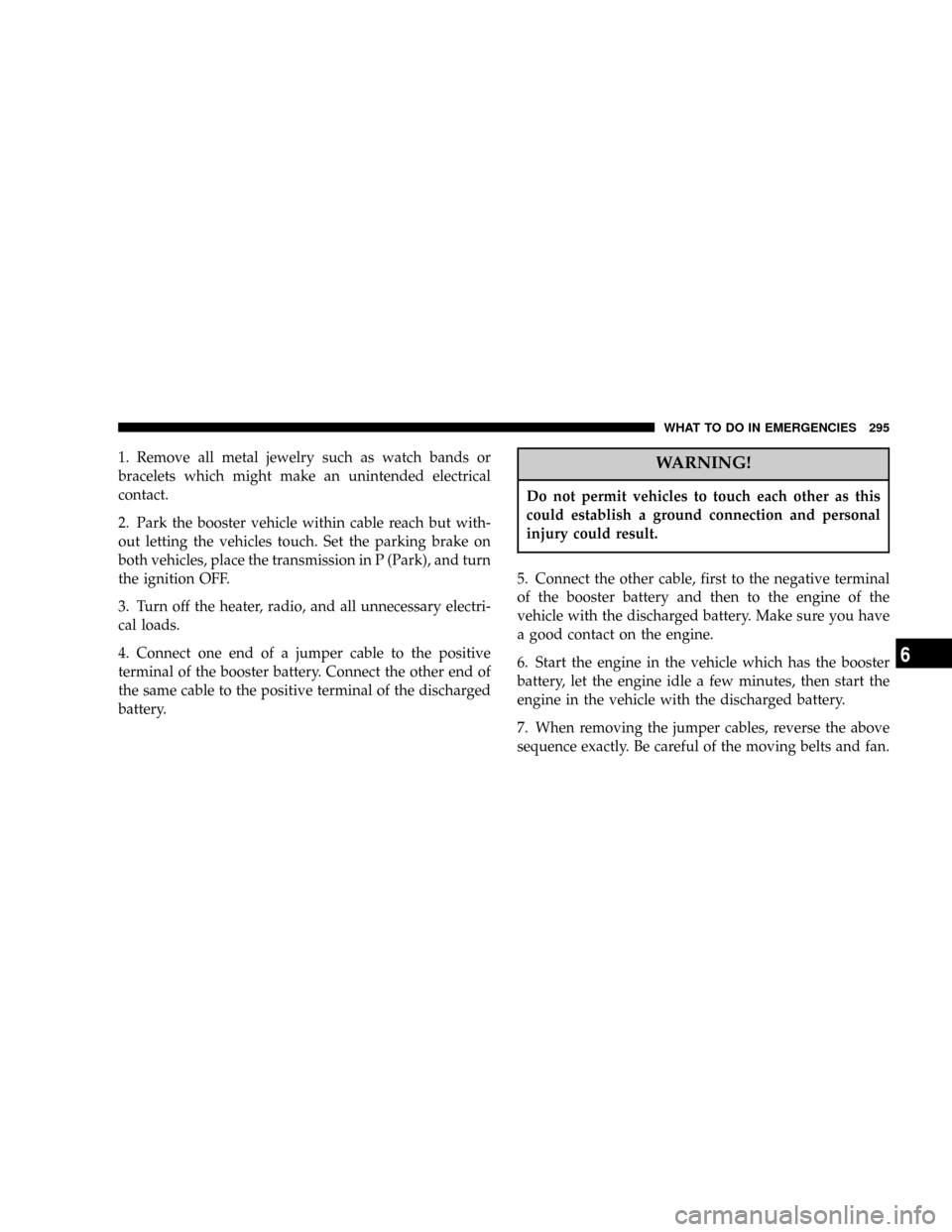
1. Remove all metal jewelry such as watch bands or
bracelets which might make an unintended electrical
contact.
2. Park the booster vehicle within cable reach but with-
out letting the vehicles touch. Set the parking brake on
both vehicles, place the transmission in P (Park), and turn
the ignition OFF.
3. Turn off the heater, radio, and all unnecessary electri-
cal loads.
4. Connect one end of a jumper cable to the positive
terminal of the booster battery. Connect the other end of
the same cable to the positive terminal of the discharged
battery.WARNING!
Do not permit vehicles to touch each other as this
could establish a ground connection and personal
injury could result.
5. Connect the other cable, first to the negative terminal
of the booster battery and then to the engine of the
vehicle with the discharged battery. Make sure you have
a good contact on the engine.
6. Start the engine in the vehicle which has the booster
battery, let the engine idle a few minutes, then start the
engine in the vehicle with the discharged battery.
7. When removing the jumper cables, reverse the above
sequence exactly. Be careful of the moving belts and fan.
WHAT TO DO IN EMERGENCIES 295
6
Page 296 of 395
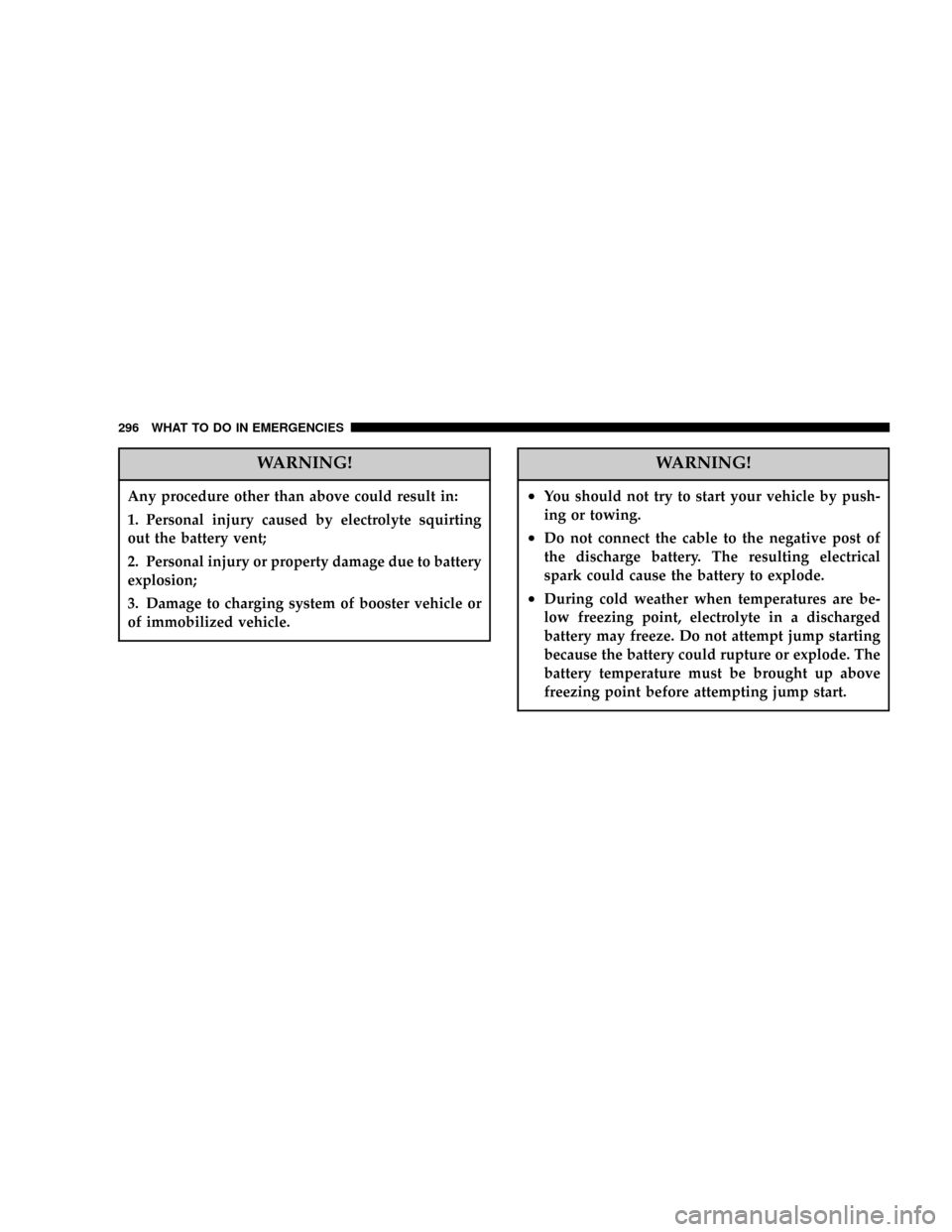
WARNING!
Any procedure other than above could result in:
1. Personal injury caused by electrolyte squirting
out the battery vent;
2. Personal injury or property damage due to battery
explosion;
3. Damage to charging system of booster vehicle or
of immobilized vehicle.
WARNING!
²You should not try to start your vehicle by push-
ing or towing.
²Do not connect the cable to the negative post of
the discharge battery. The resulting electrical
spark could cause the battery to explode.
²During cold weather when temperatures are be-
low freezing point, electrolyte in a discharged
battery may freeze. Do not attempt jump starting
because the battery could rupture or explode. The
battery temperature must be brought up above
freezing point before attempting jump start.
296 WHAT TO DO IN EMERGENCIES
Page 381 of 395

Diagnostic System, Onboard................ 301
Dimmer Switch, Headlight................. 119
Dipsticks
Power Steering........................ 314
Disposal
Antifreeze (Engine Coolant)............... 321
Door Locks............................. 26
Door Locks, Automatic.................... 27
Door Opener, Garage..................... 145
Drive Belts............................ 309
DVD Player (Video Entertainment System)...... 214
Electric Remote Mirrors.................... 76
Electrical Outlet, Auxiliary (Power Outlet)...... 155
Electronic Brake Control System............. 131
Electronic Speed Control (Cruise Control)...... 128
Electronic Stability Program (ESP)............ 134
Electronic Throttle Control Warning Light...... 178
Electronic Vehicle Information Center (EVIC) . 176,179Emergency, In Case of
Freeing Vehicle When Stuck............... 241
Hazard Warning Flasher................. 292
Jump Starting......................... 293
Emission Control System Maintenance......302,350
Engine
Air Cleaner.......................... 310
Air Cleaner Filter...................... 310
Break-In Recommendations................ 64
Checking Oil Level..................... 305
Compartment......................... 300
Compartment Identification............... 300
Coolant (Antifreeze).................... 318
Cooling............................. 318
Exhaust Gas Caution..................65,273
Fails to Start.......................... 235
Flooded, Starting...................... 235
Fuel Requirements..................270,346
Oil ..............................305,346
INDEX 381
10
Page 384 of 395

Heated Mirrors.......................... 77
Heated Seats........................... 103
High Beam Indicator..................... 172
High Beam/Low Beam Select (Dimmer) Switch . . 119
Hitches
Trailer Towing........................ 281
Holder, Cup........................... 157
HomeLinkt(Garage Door Opener) Transmitter . . . 145
Hood Release.......................... 112
Hoses.............................323,327
Ignition
Key ................................. 14
Illuminated Entry........................ 19
Infant Restraint.......................... 54
Inflation Pressure Tires.................... 260
Information Center, Vehicle................. 179
Instrument Cluster....................171,172
Instrument Panel and Controls.............. 170Instrument Panel Lens Cleaning............. 332
Integrated Power Module (Fuses)............ 338
Interior Appearance Care.................. 331
Interior Fuses.......................... 333
Interior Lighting........................ 119
Interior Lights....................... 117,119
Intermittent Wipers (Delay Wipers)........... 122
Introduction............................. 4
Jump Starting.......................... 293
Key, Programming........................ 17
Key, Replacement........................ 17
Key, Sentry (Immobilizer)................... 15
Key-In Reminder......................... 15
Keyless Entry System...................... 19
Keys................................. 14
Lap/Shoulder Belts....................... 35
384 INDEX
Page 395 of 395
INTRODUCTION INTRODUCTION Roll Over WarningHOW TO USE THIS MANUAL WARNINGS AND CAUTIONS VEHICLE IDENTIFICATION NUMBER VEHICLE MODIFICATIONS / ALTERATIONS THINGS TO KNOW BEFORE STARTING YOUR VEHICLE A WORD
ABOUT YOUR KEYS Ignition Key RemovalKey-In-Ignition ReminderSENTRY KEY IMMOBILIZER SYSTEM Important Note About ServiceReplacement KeysCustomer Key ProgrammingGeneral InformationSECURITY ALARM SYSTEM - IF EQUIPPED To Set the Alarm
To Disarm the SystemILLUMINATED ENTRY REMOTE KEYLESS ENTRY To Unlock the DoorsTo Lock the DoorsTo Release the Liftgate Flipper GlassUsing The Panic AlarmGeneral InformationTransmitter Battery ServiceREMOTE STARTING SYSTEM - IF EQUIPPED
DOOR LOCKS Manual Door LocksPower Door Locks - If EquippedChild Protection Door LockWINDOWS Power WindowsWind BuffetingLIFTGATE Liftgate FlipperGlassOCCUPANT RESTRAINTS Lap/Shoulder BeltsLap/Shoulder Belt Operating InstructionsAdjustable Upper
Shoulder Belt AnchorageAutomatic Locking Mode - If EquippedEnergy Management FeatureSeat Belt PretensionersSeat Belts and Pregnant WomenSeat Belt ExtenderDriver And Front Passenger Supplemental Restraint Systems (SRS) Child RestraintENGINE BREAK-IN
RECOMMENDATIONS SAFETY TIPS Exhaust GasSafety Checks You Should Make Inside The VehicleSafety Checks You Should Make Outside The VehicleUNDERSTANDING THE FEATURES OF YOUR VEHICLE MIRRORS Automatic Dimming MirrorOutside Mirrors
Exterior Mirrors Folding FeatureDrivers Outside Automatic Dimming Mirror - If EquippedPower Remote Control Outside MirrorsHeated Remote ControlMirrors - If EquippedLighted Vanity Mirrors - If EquippedHANDS-FREE COMMUNICATION (UConnect) - IF EQUIPPED
OperationsPhone Call FeaturesUConnect System FeaturesAdvanced Phone ConnectivityThings You Should Know About Your UConnect SystemSEATS Front Manual Seat AdjustmentFront Seat Adjustment - ReclineManual Lumbar Support Adjustment8 - Way Drivers Power
Seat4 - Way Passengers Power Seat - If EquippedHead RestraintsHeated Seats-If Equipped60/40 Split Rear SeatDRIVER MEMORY SEAT - IF EQUIPPED SettingMemory Positions and Linking Remote Keyless Entry Transmitter to MemoryMemory Position RecallTo Disable
A Transmitter Linked to MemoryEasy Entry/Exit SeatTO OPEN AND CLOSE THE HOOD LIGHTS Multi-Function Control LeverBattery Saver Feature-Exterior/Interior LightsHeadlights and Parking LightsAutomatic Headlight System - If EquippedSmartBeams - If Equipped
Instrument Panel and Interior LightsDaytime Running Lights - If EquippedLights-On ReminderFog Lights - If EquippedTurn SignalsHigh Beam SwitchPassing LightHeadlight Time DelayInterior LightsFront Map/Reading LightsWINDSHIELD WIPERS AND WASHERS Mist
Speed Sensitive Intermittent Wiper SystemRain Sensing Wipers-If EquippedTILT STEERING COLUMN ADJUSTABLE PEDALS - IF EQUIPPED ELECTRONIC SPEED CONTROL To ActivateTo Set at a Desired SpeedTo DeactivateTo Resume SpeedTo Vary the Speed
SettingTo Accelerate for PassingDriving Up or Down HillsELECTRONIC BRAKE CONTROL SYSTEM ABS (Anti-Lock Brake System)TCS (Traction Control System)BAS (Brake Assist System)ERM (Electronic Roll Mitigation)ESP (Electronic Stability Program)ESP/BAS
Warning Lamp and ESP/TCS Indicator LightREAR PARK ASSIST SYSTEM- IF EQUIPPED Rear Park Assist SensorsRear Park Assist Warning DisplayEnable/Disable the Rear Park Assist SystemService the Rear Park Assist SystemCleaning the Rear Park Assist System
REAR CAMERA - IF EQUIPPED Turning the Rear Camera OnTurning the Rear Camera OffOVERHEAD CONSOLE Courtesy/Reading LightsSunglasses StorageGARAGE DOOR OPENER Programming HomeLinkCanadian Programming/Gate ProgrammingUsing HomeLink
Erasing HomeLink ButtonsReprogramming a Single HomeLink ButtonSecurityPOWER SUNROOF - IF EQUIPPED Opening Sunroof - ExpressClosing Sunroof - ExpressPinch Protect FeaturePinch Protect OverrideVenting Sunroof - ExpressSunshade OperationWind
BuffetingSunroof MaintenanceIgnition Off OperationSunroof Fully ClosedPOWER OUTLET CUP HOLDERS CARGO AREA FEATURES Cargo LightRear Storage CompartmentRetractable Cargo Area CoverCargo Tie-Down HooksCargo Load FloorREAR WINDOW
FEATURES Rear Window Wiper/Washer - If EquippedRear Window Defroster - If EquippedUNDERSTANDING YOUR INSTRUMENT PANEL INSTRUMENT PANEL AND CONTROLS INSTRUMENT CLUSTER INSTRUMENT CLUSTER DESCRIPTION ELECTRONIC
VEHICLE INFORMATION CENTER Customer Programmable FeaturesCompass/Temperature/Trip ComputerTrip ComputerRADIO GENERAL INFORMATION Radio Broadcast SignalsTwo Types of SignalsElectrical DisturbancesAM ReceptionFM ReceptionSALES CODE
RAQ - AM/FM/CD (6-DISC) RADIO WITH OPTIONAL SATELLITE RADIO, HANDS FREE PHONE, AND VEHICLE ENTERTAINMENT SYSTEMS (VES) CAPABILITIES Operating Instructions - Radio ModeOperation Instructions - (CD MODE for CD Audio Play)LOAD/EJECT
Button (CD Mode for CD Audio Play)Notes On Playing MP3 FilesOperation Instructions - (CD Mode for MP3 Audio Play)LOAD/EJECT Button (CD Mode for MP3 Play)SALES CODE REC - AM/FM/CD (6-DISC) RADIO WITH NAVIGATION SYSTEM Operating Instructions
- Satellite Radio (If Equipped)REC Setting the ClockAudio Clock DisplayVIDEO ENTERTAINMENT SYSTEM (SALES CODE XRV) - IF EQUIPPED SATELLITE RADIO - IF EQUIPPED System ActivationElectronic Serial Number/Sirius Identification Number (ESN/SID)
Selecting Satellite Mode in RAQ RadiosSelecting a ChannelStoring and Selecting Pre-Set ChannelsUsing the PTY (Program Type) Button - If EquippedPTY Button SCANPTY Button SEEKSatellite AntennaReception QualityREMOTE SOUND SYSTEM CONTROLS Radio
OperationCD PlayerCD/DVD DISC MAINTENANCE RADIO OPERATION AND CELLULAR PHONES CLIMATE CONTROLS Automatic Temperature ControlOperating TipsSTARTING AND OPERATING STARTING PROCEDURES Normal StartingExtreme Cold Weather
(below -20 degrees F (-29 degrees C)If Engine Fails to StartAfter StartingAUTOMATIC TRANSMISSION Brake/Transmission Interlock System5-Speed Automatic TransmissionGear RangesRocking the VehicleAUTOSTICK Autostick OperationAutostick General Information
PARKING BRAKE ANTI-LOCK BRAKE SYSTEM POWER STEERING TIRE SAFETY INFORMATION Tire Markings Tire Identification Number (TIN)Tire Loading and Tire PressureTIRES - GENERAL INFORMATION Run Flat TiresTire PressureTire Inflation PressuresTire
Pressures for High Speed OperationRadial-Ply TiresTire SpinningTread Wear IndicatorsLife of TireReplacement TiresAlignment and BalanceTIRE ROTATION RECOMMENDATIONS TIRE PRESSURE MONITOR SYSTEM (TPMS) Premium SystemGeneral InformationFUEL
REQUIREMENTS Reformulated GasolineGasoline/Oxygenate BlendsMMT In GasolineMaterials Added to FuelFuel System CautionsCarbon Monoxide WarningsADDING FUEL Fuel Filler Cap (Gas Cap)TRAILER TOWING Common Towing DefinitionsTrailer Hitch
ClassificationTrailer Towing Weights (Maximum Trailer Weight Ratings)Trailer and Tongue WeightTowing RequirementsTowing TipsRECREATIONAL TOWING (BEHIND MOTORHOME, ETC.) WHAT TO DO IN EMERGENCIES HAZARD WARNING FLASHERS IF YOUR
ENGINE OVERHEATS JUMP STARTING MAINTAINING YOUR VEHICLE ENGINE COMPARTMENT - 6.1L ONBOARD DIAGNOSTIC SYSTEM - OBD II Loose Fuel Filler Cap MessageEMISSIONS INSPECTION AND MAINTENANCE PROGRAMS REPLACEMENT PARTS
DEALER SERVICE MAINTENANCE PROCEDURES Engine OilEngine Oil FilterDrive Belts - Check Condition and TensionerSpark PlugsEngine Air Cleaner FilterFuel FilterCatalytic ConverterMaintenance-Free BatteryAir Conditioner MaintenancePower Steering Fluid Check
Body LubricationWindshield Wiper BladesWindshield Washers - Front and RearExhaust SystemCooling SystemHoses And Vacuum/Vapor HarnessesBrake SystemBrake Fluid Level CheckFuel System HosesAutomatic TransmissionFront And Rear Wheel Bearings
Appearance Care And Protection From CorrosionFUSE PANEL Interior FusesUnderhood Fuses (Power Distribution Center) Underhood Fuses (Integrated Power Module) VEHICLE STORAGE REPLACEMENT BULBS BULB REPLACEMENT Head LightFront Turn Signal
Front Fog LightRear Tail, Stop, Turn Signal, and Back-Up LightsCenter High Mounted Stop Light (CHMSL)FLUID CAPACITIES FLUIDS, LUBRICANTS, AND GENUINE PARTS EngineChassisMAINTENANCE SCHEDULES EMISSION CONTROL SYSTEM MAINTENANCE MAINTENANCE SCHEDULES Schedule BSchedule AIF YOU NEED CONSUMER ASSISTANCE SUGGESTIONS FOR OBTAINING SERVICE FOR YOUR VEHICLE Prepare For The AppointmentPrepare A ListBe Reasonable With RequestsIF YOU NEED ASSISTANCE
WARRANTY INFORMATION (U.S. Vehicles Only) MOPAR PARTS REPORTING SAFETY DEFECTS In CanadaPUBLICATION ORDER FORMS DEPARTMENT OF TRANSPORTATION UNIFORM TIRE QUALITY GRADES TreadwearTraction GradesTemperature Grades
INDEX